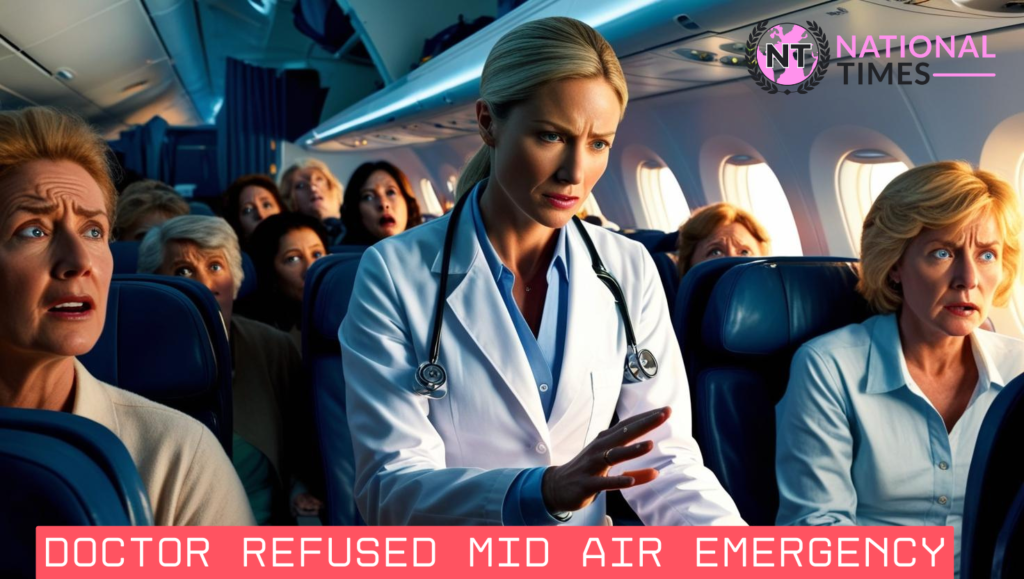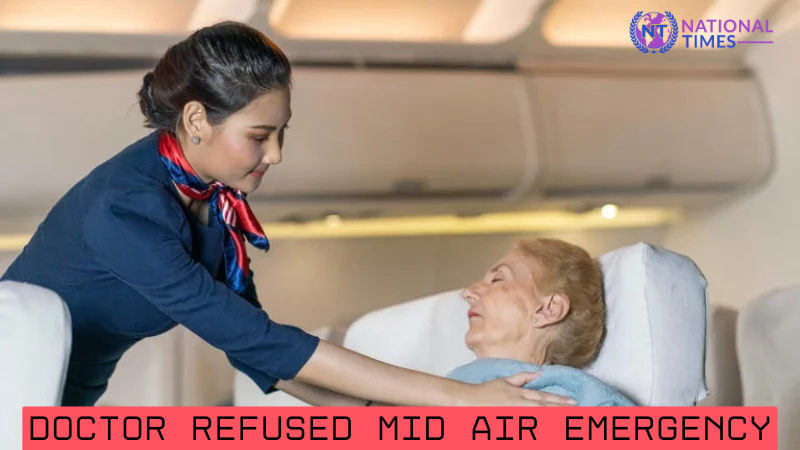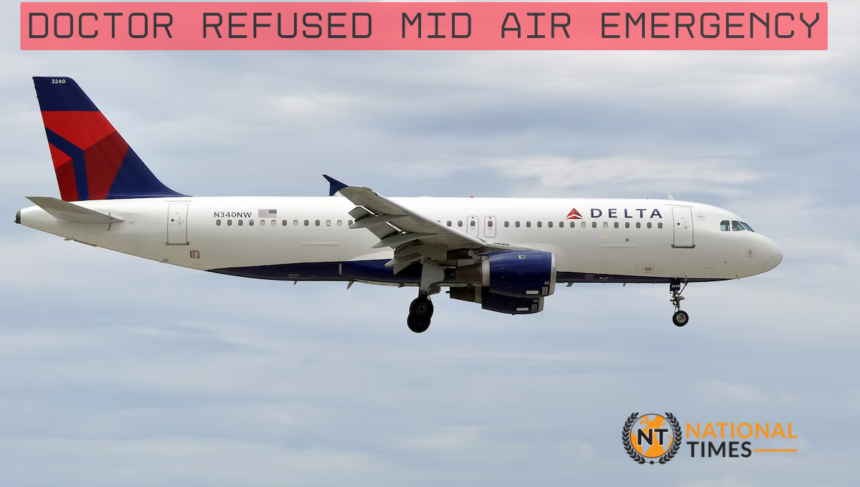In-flight medical doctor refused mid air emergency are rare but significant events that can occur at any time during a flight. Passengers may experience health crises that demand immediate medical attention. In many cases, flight crews request assistance from doctors or medical professionals onboard, but what happens when a doctor refuses to help? Understanding the reasons behind such decisions, the legal and ethical considerations, and the role of the airline’s policies is important for passengers and medical professionals alike. This article delves into the reasons why some doctors may decline to provide medical assistance during mid-air emergencies and explore the broader context of in-flight medical care.
Why Do Some Doctors Decline In-Flight Medical Assistance?
While it might seem surprising for a doctor to refuse help during a medical doctor refused mid air emergency, there are several reasons why this might occur. Many factors, both personal and professional, influence a doctor’s decision in such situations.
One primary reason is the uncertainty of the situation. In-flight medical emergencies often present unique challenges, such as limited medical equipment and the inability to physically assess the patient in a controlled environment. A doctor may be hesitant to make a diagnosis or administer treatment without having access to necessary resources, or because of the high-risk nature of providing care without proper tools or backup.
Another factor is the legal liability involved. Doctors, especially those practicing outside their area of expertise, may be concerned about potential legal repercussions. If the patient’s condition worsens or if there is a negative outcome, a doctor could be held liable for any complications that arise. The fear of lawsuits or malpractice claims is a significant deterrent for many medical professionals when they are put in a position to make life-or-death decisions without sufficient information.
Additionally, some doctors may be uncomfortable with the ethical implications of intervening without the necessary support or authorization. Without a clear understanding of the patient’s medical history, a doctor may feel that they cannot provide the best possible care. This is compounded by the inability to follow up or monitor the patient after the flight, further discouraging intervention.
Legal and Ethical Considerations for Doctors in Mid-Air Emergencies
The refusal of a doctor to assist during an in-flight emergency also involves a complex set of legal and ethical concerns. Legally, the circumstances in which a doctor is expected to assist in an emergency can be murky. The Good Samaritan laws, which are intended to protect medical professionals who provide emergency care, vary from state to state and sometimes even across countries.
These laws generally offer protection to doctors from legal liability when offering help in emergencies, provided the doctor acts in good faith and to the best of their ability. However, these laws typically apply only to situations where the doctor is acting within their professional competence and the context allows for informed decisions. In the case of in-flight medical emergencies, where the doctor may not have access to critical information or the proper facilities, this protection may not be as clear-cut.
Ethically, doctors are bound by the Hippocratic Oath, which requires them to provide medical assistance in emergencies. However, in the unique context of a mid-air emergency, where a doctor is often asked to assist without the full support of a healthcare team or medical facilities, some professionals may feel ethically torn. They may be concerned about making a misdiagnosis or taking a course of action that could result in harm to the patient. The absence of adequate resources for monitoring the patient after the flight further complicates matters.
Airline Policies on In-Flight Medical Assistance
Airlines typically have policies in place to deal with medical emergencies that occur mid-flight. These policies are designed to ensure that the flight crew can handle the situation in a way that minimizes risk to the passenger while also protecting the airline and its staff. However, the effectiveness of these policies varies, and not all airlines are equally prepared for medical emergencies.
Many airlines rely on medical assistance from onboard passengers with medical training or credentials. They have systems in place for communicating with ground-based medical professionals who can help guide the in-flight medical response. However, these systems can only provide so much support when the situation requires immediate, hands-on care. While airlines may offer assistance through their communication channels, they cannot compel a doctor to help, especially when the doctor’s safety and well-being may be at risk in an unfamiliar, confined environment.

Understanding Good Samaritan Laws
Good Samaritan laws are vital for encouraging doctors to provide emergency care outside of their usual practice settings. These laws generally protect medical professionals from legal consequences as long as they act in good faith and within their training. In-flight, these laws are often invoked to ensure that a doctor is not held liable for offering help during an emergency. However, the scope of these laws can vary, especially when the doctor’s actions are considered outside their area of expertise.
Doctors who are asked to assist during in-flight emergencies may feel uncertain about the limitations of these laws. If they are unsure whether their actions will fall under the protection of Good Samaritan laws, they may opt to decline to help, fearing potential legal repercussions if something goes wrong.
The Role of Flight Crew in Medical Emergencies
In-flight medical emergencies require the coordination of the flight crew, medical professionals onboard, and ground-based support teams. While doctors are often asked to assist, the flight crew plays an essential role in managing the emergency. Flight attendants are trained to handle basic first aid and assist with life-saving measures, such as administering CPR or using an automated external defibrillator (AED) when necessary. However, the crew’s training is limited, and they typically rely on the expertise of onboard doctors when the situation is beyond their training.
The flight crew is also responsible. For ensuring that medical emergencies. handled efficiently without compromising the safety of the rest of the passengers. They must communicate clearly with the passengers and the medical professionals involved in the situation, ensuring that everyone understands the steps being taken.
Impact of Alcohol Consumption on Medical Decisions
Alcohol consumption is another factor that can affect in-flight medical decisions. While it’s rare for alcohol to play a role in mid-air medical emergencies, it is important to note that alcohol can impact a person’s physical condition. Passengers who are. Intoxicated may present with symptoms. That could. Be. Misinterpreted. As. A medical emergency, such as fainting, nausea, or confusion.
In such situations, the doctor may be hesitant to intervene due to the unclear nature of the condition. Alcohol can mask or mimic serious health issues, making it more difficult for a doctor to make an accurate diagnosis. Additionally, doctors may be hesitant to treat patients who are under the influence of alcohol, as it could complicate their ability to assess the situation or provide appropriate care.
It seems like you are asking for a “Bio Table,” but I still need a little more detail to ensure I provide the exact format or structure you’re asking for.
Here is an example of a basic Bio Table with typical categories for a personal biography:
| Category | Details |
|---|---|
| Name | John Doe |
| Date of Birth | January 1, 1985 |
| Profession | Doctor |
| Nationality | American |
| Education | M.D. from XYZ University |
| Specialization | Cardiology |
| Years of Experience | 15 years |
| Notable Achievements | Developed a new cardiac treatment protocol |
| Awards | Medical Excellence Award, 2019 |
| Social Media | Twitter: @JohnDoeMD, LinkedIn: /JohnDoeMD |
If this is the type of table you’re asking for, please let me know, or if you need a specific format or additional information, feel free to clarify!
Real-Life Examples of Doctors Assisting in Mid-Air Emergencies
There are numerous instances where doctors have stepped in to help during mid-flight emergencies. Some have saved lives by providing life-saving treatments, performing CPR, or offering advice to the flight crew. These cases often make headlines and highlight the importance of having medical professionals onboard during flights.
One famous example occurred in 2001 when a doctor aboard a United Airlines flight assisted a passenger who was experiencing a heart attack. The doctor was able to stabilize the passenger using onboard medical equipment, and the passenger survived the ordeal. While these instances are inspiring, they also underscore the challenges and risks faced by medical professionals in such unique situations.
Challenges Faced by Doctors in Providing In-Flight Medical Assistance
Doctors are. Faced with. Numerous challenges when responding to medical emergencies mid-air. The most significant challenge is the lack of immediate access to proper medical equipment and facilities. Onboard medical kits. May be. Limited in scope. And the doctor may not have access to the patient’s medical history, making diagnosis and treatment difficult.
Furthermore, the confined space of an aircraft can make it challenging to perform procedures or even assess a patient properly. This lack of space, combined with turbulence or other in-flight issues, can hinder a doctor’s ability to offer the best possible care.
The Importance of Clear Communication During In-Flight Medical Emergencies
Clear communication is essential when handling mid-air medical doctor refused mid air emergency . The flight crew must communicate effectively with the onboard medical professionals and provide them with as much information as possible. Additionally. Medical professionals should work. Closely with. The flight crew to ensure. The best course. Of action. Is followed.

Training Flight Crew for Medical Emergencies
One way to improve the management of in-flight medical emergencies is through better training for flight crews. Flight attendants should receive more advanced training in first aid, CPR, and other emergency medical procedures. This would ensure that they can assist more effectively during medical situations and provide better support to any doctors onboard.
Ensuring Access to Medical Equipment on Flights
Another way to improve in. Flight medical responses is by ensuring. That aircraft. Are. Equipped. With comprehensive medical kits. These kits should include a wider range of tools and medications, enabling doctor refused mid air emergency to provide better care during emergencies.
Legal Protections for Medical Professionals Assisting in Emergencies
Medical professionals who assist in emergencies, including those onboard aircraft, should have access to legal protections. These protections can help alleviate concerns about potential lawsuits or malpractice claims.
Navigating the Complexities of In-Flight Medical Assistance
Navigating the complexities of in-flight medical assistance requires careful consideration of the legal, ethical, and practical challenges involved. It is important to strike a balance between providing. Care and ensuring. That medical professionals. Are not. Put. At risk of liability or harm.
The Bottom Line
In-flight medical doctor refused mid air emergency are rare, but they present a unique set of challenges for both passengers and medical professionals. While many doctors will assist when called upon, some may decline due to legal, ethical, and practical concerns. Understanding these factors can help passengers better appreciate the complexities involved and the reasons behind a doctor’s decision to decline assistance.






